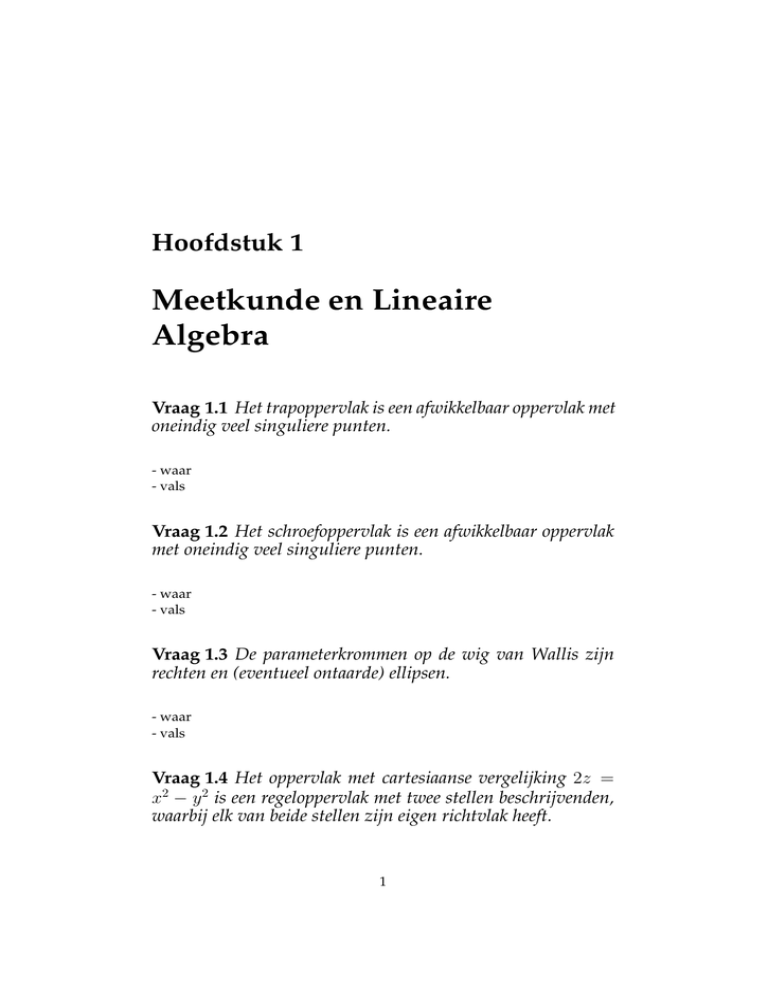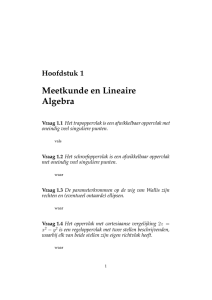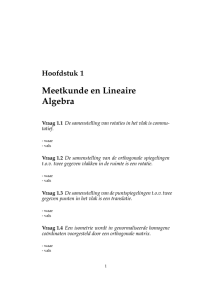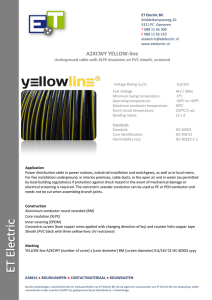Hoofdstuk 1 Meetkunde en Lineaire Algebra
advertisement

Hoofdstuk 1 Meetkunde en Lineaire Algebra Vraag 1.1 Het trapoppervlak is een afwikkelbaar oppervlak met oneindig veel singuliere punten. - waar - vals Vraag 1.2 Het schroefoppervlak is een afwikkelbaar oppervlak met oneindig veel singuliere punten. - waar - vals Vraag 1.3 De parameterkrommen op de wig van Wallis zijn rechten en (eventueel ontaarde) ellipsen. - waar - vals Vraag 1.4 Het oppervlak met cartesiaanse vergelijking 2z = x2 − y 2 is een regeloppervlak met twee stellen beschrijvenden, waarbij elk van beide stellen zijn eigen richtvlak heeft. 1 - waar - vals Vraag 1.5 Er bestaan hermitische matrices in C2×2 waarvan het spoor 0 is en de determinant positief. - waar - vals Vraag 1.6 Er bestaan nilpotente matrices die diagonaliseerbaar zijn. - waar - vals Vraag 1.7 Zij u ∈ Rn×1 , u 6= 0, n > 1. Dan is 0 ∈ σ(u uT ) met algebra¨ısche en meetkundige multipliciteit gelijk aan n−1. - waar - vals Vraag 1.8 Zij u ∈ Cn×1 , u 6= 0, n > 1. Dan bevat σ(u u† ) twee verschillende elementen. - waar - vals Vraag 1.9 Zij x, y twee van nul verschillende, orthogonale elementen in Rn×1 . Dan bezit xy T enkel de eigenwaarde nul. - waar - vals Vraag 1.10 Zij A ∈ Cn×n . Dan hebben de matrices A + I en A − I dezelfde eigenvectoren en zijn de spectra van beide matrices over een afstand 2 t.o.v. elkaar verschoven. 2 - waar - vals 3 Hoofdstuk 2 Natuurkunde I Vraag 2.1 Each of two small non-conducting spheres is charged positively, the combined charge being 40 µC. When the two spheres are 50 cm apart, each sphere is repelled from the other by a force of magnitude 2.0 N. Determine the magnitude of the smaller of the two charges. - 1.4 µC - 1.1 µC - 2.0 µC - 3.3 µC - 17 µC Vraag 2.2 In the figure, if Q = 30 µC, q = 5.0 µC, and d = 30 cm, what is the magnitude of the electrostatic force on q? - 15 N - 23 N - zero - 7.5 N - 38 N Vraag 2.3 If Q = 20 µC and L = 60 cm, what is the magnitude of the electrostatic force on any one of the charges shown? 4 - 25 N - 19 N - 15 N - 9.1 N - 14 N Vraag 2.4 A uniformly charged rod (length = 2.0 m, charge per unit length = 5.0 nC/m) is bent to form one quadrant of a circle. What is the magnitude of the electric field at the center of the circle? - 62 N/C - 56 N/C - 50 N/C - 44 N/C - 25 N/C Vraag 2.5 When gravitational, magnetic and any forces other than static electric forces are not present, electric field lines in the space surrounding a charge distribution show - the directions of the forces that exist in space at all times. - only the directions in which static charges would accelerate when at points on those lines. - only the directions in which moving charges would accelerate when at points on those lines. - tangents to the directions in which either static or moving charges would accelerate when passing through points on those lines. - the paths static or moving charges would take. 5 Vraag 2.6 A positively charged particle is moving in the +ydirection when it enters a region with a uniform electric field pointing in the +x-direction. Which of the diagrams below shows its path while it is in the region where the electric field exists. The region with the field is the region between the plates bounding each figure. The field lines always point to the right. The x-direction is to the right; the y-direction is up. - - - - - 6 Vraag 2.7 Three pith balls supported by insulating threads hang from a support. We know that ball X is positively charged. When ball X is brought near balls Y and Z without touching them, it attracts Y and repels Z. We can conclude that - Y has a negative charge. - Z has a negative charge. - Y has a positive charge. - Z has a positive charge. - Z is neutral (has no net charge.) Vraag 2.8 Two identical pith balls supported by insulating threads hang side by side and close together, as shown below. One is positively charged; the other is neutral. We can conclude that - all field lines leaving the positively charged pith ball end on the neutral pith ball. - some of the field lines leaving the positively charged pith ball end on the neutral pith ball. - none of the field lines leaving the positively charged pith ball end on the neutral pith ball. - positive charge is transferred along the field lines until both balls have equal charges. - positive charge is transferred along the field lines until both balls hang along vertical lines. 7 Vraag 2.9 Two imaginary spherical surfaces of radius R and 2R respectively surround a positive point charge Q located at the center of the concentric spheres. When compared to the number of field lines N1 going through the sphere of radius R, the number of electric field lines N2 going through the sphere of radius 2R is - N2 - N2 - N2 - N2 - N2 = 14 N1 = 21 N1 = N1 = 2N1 = 4N1 Vraag 2.10 A uniform electric field E~I is present in the region between infinite parallel plane plates A and B and a uniform electric field E~II is present in the region between infinite parallel plane plates B and C. When the planes are vertical, E~I is directed to the right and E~II to the left. The signs of the charges on plates A, B and C may be - (-, -, -) - (+, -, -) - (+, -, +) - (+, +, +) - any one of the above 8


